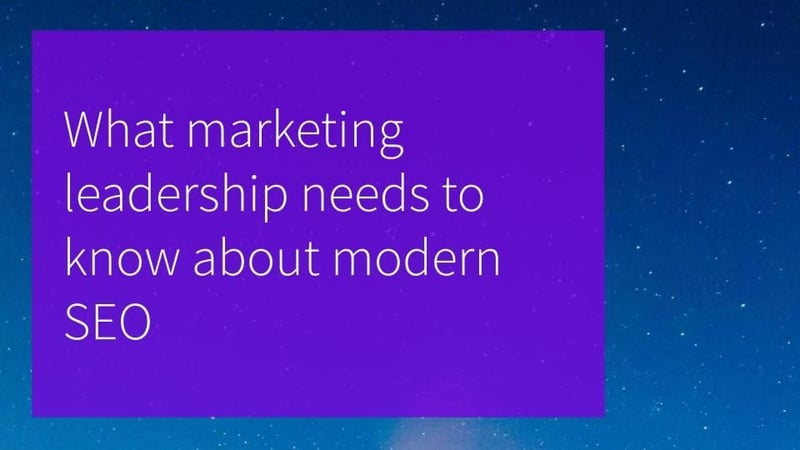I know a lot of folks who started out in SEO, and are now in marketing leadership positions. One challenge, when this happens, is that it’s hard to stay plugged in to SEO news, but you still have oversight of the SEO channel.
This article started as a tweet thread. You can see the original, along with its discussion, here:
I know a lot of folks who started out in SEO, and are now in marketing leadership positions.
— Will Critchlow (@willcritchlow) August 24, 2021
One challenge is that it’s hard to stay plugged in to SEO news, but you still have oversight of the SEO channel.
Does this sound like you? Here’s what you need to know:
If this applies to you, read on. If it sounds like your boss, feel free to share with them. I know there’s a lot of bad information and rumour, so this is all based on the evidence we get from the SEO A/B tests we get to run at SearchPilot (background: what is SEO A/B testing?).
Here’s what Google is really doing in the following key SEO areas (click through to read the individual SEO A/B test results backing each point):
1. JavaScript: improving, but not perfect
Google can execute and index an awful lot of JavaScript
BUT
Google’s JavaScript execution is not perfect, it can cause organic search problems, and underperformance through outright failing, or through the fact that it takes a lot of resource so only top pages are prioritised.
It does appear, though, that (in keeping with all the official line) a lot of it is to do with user experience. Where you upgrade the UX by using JS, search performance can IMPROVE!
2. User Experience (UX): growing in importance
Google really is serious about rewarding the best possible UX. In particular, they aren’t kidding about interstitials harming organic search performance.
3. Hidden content: still a big deal
While we’re talking about UX. You’ll remember the “hidden content” shenanigans of yesteryear. The modern equivalent is text hidden in tabs etc. We’ve seen uplifts from bringing it out of tabs and making it visible.
This is an especially big deal because of mobile-first indexing and the prevalence of tabs and accordions in mobile design.
4. Search result page (SERP) appearance: makes a huge difference to actual clicks and traffic
In light of recent changes where Google is choosing to rewrite more title tags in the SERP, we will be doing more testing in this area, because that title is one of the most influential elements on clickthrough rate.
For example, brand matters and it’s an area where experienced SEOs are most liable to screw up. It’s really easy to make a strongly negative title tag change:
It’s quite possible that Google will get better at writing display titles than you are. They may already be better than you at writing meta descriptions because they can be query-specific (see also).
5. Structured data: can move the needle
But a lot of the benefit is in having it when your competitors don’t, so it’s a bit of an arms race (or prisoner’s dilemma, given it gives Google additional data).
6. Internal links: still really powerful and important
But they are commonly misunderstood. The big takeaways from our testing are:
- Internal links are important (these tests are some of our most consistently statistically significant)
- We have surprisingly often found big benefits to the pages where the links are added, not just to the targets of those links
- In fact, we have seen cases where recipient page impacts were undetectable or even negative, while the linking pages saw a benefit
- Some of our hardest-to-predict test results have been internal linking tests!
I wanted to talk this week about one of the most advanced SEO subjects there is: internal linking
— Will Critchlow (@willcritchlow) September 3, 2021
7. Content: quality is in the eye of the beholder
Quality matters. Sometimes.
When it did. And when it seemed to be more about keywords on the page in text of any quality.
One thing that might not have been as true in times gone by: localising/localizing can make a major difference. And timeliness matters.
8. Assorted and perhaps surprising results
E-A-T might be real (that’s one for the grizzled veterans to pull a face at. Whether you believe it or not, our full funnel testing (CRO & SEO testing together) tends to show that it’s a good idea to improve this kind of thing when measured across both. I don’t think that should be a surprise.
And who’d have predicted that HTML ordering would still be a thing in the third decade of the 21st century?
I don’t know about you, but digging into surprising results and learning new things are what keep me interested in SEO after nearly 20 years.
Equally, if your job doesn’t allow / require you to spend as much time in the weeds as you used to and you want to get the kinds of insights I’ve shared here, based on statistically-controlled tests, we have a low-volume email list for you.
If you have any questions or want to discuss any of this, drop me a line on Twitter.
Image credit Joshua Hibbert.
